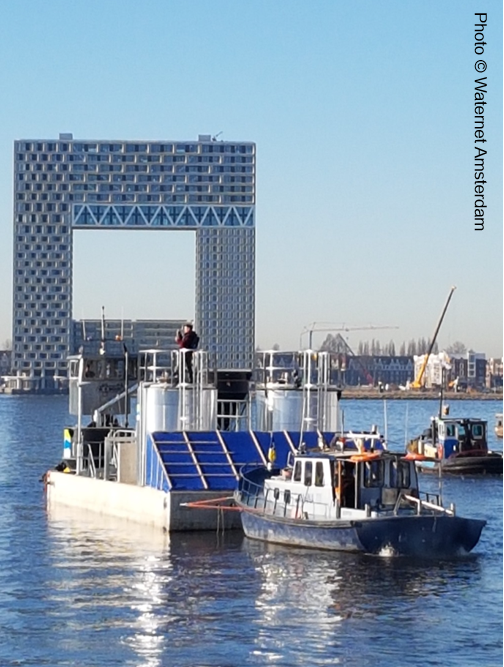4.3.3 Urban Interventions for Water Flows
Course subject(s)
Module 4. City
The next two examples show ways of how to organise water flows in a different way. Please note again what advantages and disadvantages you see in them.
Example 1: Blackwater Treatment Plant

Buiksloterham is a neighbourhood in the North of Amsterdam, The Netherlands. The former industrial site is currently re-developed as a mixed-use neighbourhood with high aims on sustainability and circularity. One of the ongoing projects is the installation of a decentralised blackwater treatment plant. Around 2000 households will eventually be part of this pilot project. In each household, special vacuum toilets will be installed. They are similar to the toilets you may know from airplanes. Via a vacuum sewage pipe system, the blackwater (excrements and urine) is transported from the toilets to the treatment plant.
The plant is floating on a platform in a small canal. Inside this plant, different types of nutrients are extracted from the blackwater. In principle, it would be possible to do this in a regular centralised wastewater treatment plant. But in this decentralised plant, the blackwater is much “fresher” and less diluted with flushing water. Therefore, it is much more efficient to extract resources from it. Via a vacuum sewage pipe system, the blackwater (excrements and urine) is transported from the toilets to the treatment plant.
The plant is floating on a platform in a small canal. Inside this plant, different types of nutrients are extracted from the blackwater. In principle, it would be possible to do this in a regular centralised wastewater treatment plant. But in this decentralised plant, the blackwater is much “fresher” and less diluted with flushing water. Therefore, it is much more efficient to extract resources from it.
Example 2: Helophyte Filters

Oosterwold is a new suburban district currently under construction south of Almere, The Netherlands. In this district, a lot of freedom is given to future homeowners. If you build a house here, you are free to decide what shape your house and even your plot have.
With this freedom comes a lot of responsibility: each plot should be autarkic. This means that the inhabitants need to generate their own energy and treat their wastewater on-site. They even need to build the streets themselves and are asked to produce food locally as much as possible.
As there is no sewage system, a lot of homeowners so far chose to build a helophyte filter on their plot. This filter can clean greywater, which is the water coming from the shower, washing machine and the kitchen. The water is filtered in an open pond, making use of different plants that can clean it before its infiltrating in the ground.

Circular Economy for a Sustainable Built Environment by TU Delft OpenCourseWare is licensed under a Creative Commons Attribution-NonCommercial-ShareAlike 4.0 International License.
Based on a work at https://online-learning.tudelft.nl/courses/circular-economy-for-a-sustainable-built-environment//.



